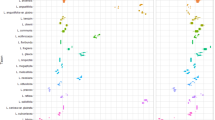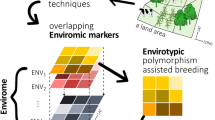Abstract
Understanding how the mating system varies with population size in plant populations is critical for understanding their genetic and demographic fates. We examined how the mating system, characterized by outcrossing rate, biparental inbreeding rate, and inbreeding coefficient, and genetic diversity varied with population size in natural populations of the biennial Sabatia angularis. We found a significant, positive relationship between outcrossing and population size. Selfing was as high as 40% in one small population but was only 7% in the largest population. Despite this pattern, observed heterozygosity did not vary with population size, and we suggest that selection against inbred individuals maintains observed heterozygosity in small populations. Consistent with this hypothesis, we found a trend of lower inbreeding coefficients in the maternal than progeny generation in all of the populations, and half of the populations exhibited significant excesses of adult heterozygosity. Moreover, genetic diversity was not related to population size and was similar across all populations examined. Our results suggest that the consequences of increased selfing for population fitness in S. angularis, a species that experiences significant inbreeding depression, will depend on the relative magnitude and consistency of inbreeding depression and the demographic cost of selection for outcrossed progeny in small populations.



Similar content being viewed by others
References
Allard RW (1975) Mating system and microevolution. Genetics 79:115–126
Barrett SCH, Kohn JR (1991) Genetic and evolutionary consequences of small population size in plant: implications for conservation. In: Falk DA, Holsinger KE (eds) Genetics and conservation of rare plants. Oxford University Press, New York, pp 3–30
Booy G, Hendriks RJJ, Smulders MJM, Van Groenendael JM, Vosman B (2000) Genetic diversity and the survival of populations. Plant Biol 2:379–395
Brown AHD, Allard RW (1970) Estimation of the mating system in open-pollinated maize populations using isozyme polymorphisms. Genetics 66:133–145
Charlesworth D, Charlesworth B (1987) Inbreeding depression and its evolutionary consequences. Annu Rev Ecol Syst 18:237–268
Cheliak WM, Pitel JA (1984) Techniques for starch gel electrophoresis of enzymes from forest tree species. Information report P1-X-42. Petawawa National Forestry Institute, Canadian Forest Service, Chalk River, ON
Cunningham SA (2000) Depressed pollination in habitat fragments causes low fruit set. Proc R Soc Lond B Bio 267:1149–1152
de Vere N, Jongejans E, Plowman A, Williams E (2009) Population size and habitat quality affect genetic diversity and fitness in the clonal herb Cirsium dissectum. Oecologia 159:59–68
Dole J, Ritland K (1993) Inbreeding depression in two Mimulus taxa measured by multigenerational changes in the inbreeding coefficient. Evolution 47:361–373
Dudash MR (1987) The reproductive biology of Sabatia angularis L. (Gentianaceae). PhD Thesis, University of Illinois at Chicago, Chicago
Dudash MR (1990) Relative fitness of selfed and outcrossed progeny in a self-compatible, protandrous species, Sabatia angularis L. (Gentianaceae): a comparison in three environments. Evolution 44:1129–1139
Dudash MR (1991) Plant size effects on female and male function in hermaphroditic Sabatia angularis (Gentianaceae). Ecology 72:1004–1012
Ellstrand NC, Elam DR (1993) Population genetic consequences of small population size: implications for plant conservation. Annu Rev Ecol Syst 24:217–242
Farris MA, Mitton JB (1984) Population density, outcrossing rate, and heterozygote superiority in ponderosa pine. Evolution 38:1151–1154
Field DL, Ayre DJ, Whelan RJ (2005) The effect of local plant density on pollinator behavior and the breeding system of Persoonia bargoensis (Proteaceae). Int J Plant Sci 166:969–977
Fischer M, Matthies D (1998a) Effects of population size on performance in the rare plant Gentianella germanica. J Ecol 86:195–204
Fischer M, Matthies D (1998b) RAPD variation in relation to population size and plant fitness in the rare Gentianella germanica (Gentianaceae). Am J Bot 85:811–819
Frankel OH, Soulé ME (1981) Conservation and evolution. Cambridge University Press, Cambridge
Ghazoul J, Liston KA, Boyle TJB (1998) Disturbance-induced density-dependent seed set in Shorea siamensis (Dipterocarpaceae), a tropical forest tree. J Ecol 86:462–473
Gilpin ME, Soulé ME (1986) Minimum viable populations: the processes of species extinctions. In: Soulé M (ed) Conservation biology: the science of scarcity and diversity. Sinauer Associates, Sunderland, pp 13-34
Goudet J (2005) Hierfstat, a package for R to compute and test hierarchical F-statistics. Molec Ecol Notes 5:184–186
Hamrick JL, Godt MJW (1996) Effects of life history traits on genetic diversity in plant species. Phil Trans R Soc B 351:1291–1298
Hamrick JL, Nason JD (1996) Consequences of dispersal in plants. In: Rhodes OE, Chesser RK, Smith MH (eds) Population dynamics in ecological space and time. University of Chicago Press, Chicago, pp 203–236
Harder LD, Barrett SCH (1996) Pollen dispersal and mating patterns in animal-pollinated plants. In: Lloyd DG, Barrett SCH (eds) Floral biology: studies on floral evolution in animal-pollinated plants. Chapman & Hall, New York, pp 140–190
Heinrich B (1979) Resource heterogeneity and patterns of movement in foraging bumblebees. Oecologia 40:235–245
Hensen I, Oberprieler C (2005) Effects of population size on genetic diversity and seed production in the rare Dictamnus albus (Rutaceae) in central Germany. Conserv Genet 6:63–73
Herlihy CR, Eckert CG (2004) Experimental dissection of inbreeding and its adaptive significance in a flowering plant, Aquilegia canadensis (Ranunculaceae). Evolution 58:2693–2703
Heschel MS, Paige KN (1994) Inbreeding depression, environmental stress, and population size variation in scarlet gilia (Ipomopsis aggregata). Conserv Biol 9:126–133
Heywood JS (1993) Biparental inbreeding depression in the self-incompatible annual plant Gaillardia pulchella (Asteraceae). Am J Bot 80:545–550
Hodgins KA, Barrett SCH (2006) Mating patterns and demography in the tristylous daffodil Narcissus triandrus. Heredity 96:262–270
Jennersten O (1988) Pollination in Dianthus deltoides (Caryophyllaceae): effects of habitat fragmentation on visitation and seed set. Conserv Biol 2:359–366
Kalisz S, Vogler DM, Hanley KM (2004) Context-dependent autonomous self-fertilization yields reproductive assurance and mixed mating. Nature 430:884–887
Kéry M, Matthies D, Spillman HH (2000) Reduced fecundity and offspring performance in small populations of the declining grassland plants Primula veris and Gentiana lutea. J Ecol 88:17–30
Knight TM, Steets JA, Vamosi JC et al (2005) Pollen limitation of plant reproduction: pattern and process. Annu Rev Ecol Syst 36:467–497
Leimu R, Mutikainen P, Koricheva J, Fischer M (2006) How general are positive relationships between plant population size, fitness and genetic variation? J Ecol 94:942–952
Levin DA (1990) The seed bank as a source of genetic novelty in plants. Am Nat 135:563–572
Levin DA, Kerster H (1969) Density-dependent gene dispersal in Liatris. Am Nat 103:61–74
Loveless MD, Hamrick JL (1984) Ecological determinants of genetic structure in plant populations. Annu Rev Ecol Syst 15:65–95
McCue KA, Holtsford TP (1998) Seed bank influences on genetic diversity in the rare annual Clarkia springvillensis (Onagraceae). Am J Bot 85:30–36
Menges ES (1991) Seed germination percentage increases with population size in a fragmented prairie species. Conserv Biol 5:158–164
Mitton JB, Linhart YB, Sturgeon KB, Hamrick JL (1979) Allozyme polymorphisms detected in mature needle tissue of ponderosa pine. J Hered 70:86–89
Murawski DA, Hamrick JL (1991) The effect of the density of flowering individuals on the mating system of nine tropical tree species. Heredity 67:167–174
Nason JD, Ellstrand NC (1995) Lifetime estimates of biparental inbreeding depression in the self-incompatible annual plant Raphanus sativus. Evolution 49:307–316
NatureServe (2009) NatureServe explorer: an online encyclopedia of life [web application], version 7.1. NatureServe, Arlington, VA. http://www.natureserve.org/explorer
Oostermeijer JGB (2000) Population viability analysis of the rare Gentiana pneumonanthe: the importance of genetics, demography and reproductive biology. In: Young AG, Clarke GM (eds) Genetics, demography and viability of fragmented populations. Cambridge University Press, Cambridge, pp 294–313
Oostermeijer JGB, van Eijck MW, van Leeuwen NC, den Nijs JCM (1995) Analysis of the relationship between allozyme heterozygosity and fitness in the rare Gentiana pneumonanthe. J Evol Biol 8:739–759
Oostermeijer JGB, Luijten SH, den Nijs HCM (2003) Integrating demographic and genetic approaches in plant conservation. Biol Conserv 113:389–398
Paschke M, Abs C, Schmid B (2002) Effects of population size and pollen diversity on reproductive success and offspring size in the narrow endemic Cochlearia bavarica (Brassicaceae). Am J Bot 89:1250–1259
Peakall R, Smouse PE (2006) Genalex 6: genetic analysis in Excel. Population genetic software for teaching and research. Molec Ecol Notes 6:288–295
Pluess AR, Stöcklin J (2004) Genetic diversity and fitness in Scabiosa columbaria in the Swiss Jura in relation to population size. Conserv Genet 5:145–156
Raijmann LEL, van Leeuwen NC, Kersten R, Oostermeijer JGB, den Nijs HCM, Menken SBJ (1994) Genetic variation and outcrossing rate in relation to population size in Gentiana pneumonanthe L. Conserv Biol 8:1014–1026
Richards CM (2000) Inbreeding depression and genetic rescue in a plant metapopulation. Am Nat 155:383–394
Ritland K (1990) A series of FORTRAN computer programs for estimating plant mating systems. J Hered 81:235–237
Ritland K (2002) Extensions of models for the estimation of mating systems using n independent loci. Heredity 88:221–228
Robledo-Arnuncio JJ, Alía R, Gil L (2004) Increased selfing and correlated paternity in a small population of a predominantly outcrossing conifer, Pinus sylvestris. Molec Ecol 13:2567–2577
Routley MB, Mavraganis K, Eckert C (1999) Effect of population size on the mating system in a self-compatible, autogamous plant, Aquilegia canadensis (Ranunculaceae). Heredity 82:518–528
Schaal BA, Levin DA (1976) The demographic genetics of Liatris cylindracea Michx. (Compositae). Am Nat 110:191–206
Schoen DJ, Clegg MT (1984) Estimation of mating system parameters when outcrossing events are correlated. Proc Natl Acad Sci USA 81:5258–5262
Sih A, Baltus M-S (1987) Patch size, pollinator behavior, and pollinator limitation in catnip. Ecology 68:1679–1690
Soltis DE, Haufler CH, Darrow DC, Gastony GJ (1983) Starch-gel electrophoresis of ferns: a compilation of grinding buffers, gel and electrode buffers, and staining schedules. Am Fern J 73:9–27
Spigler RB (2007) The reproductive consequences of reduced population size in the biennial Sabatia angularis (Gentianaceae). PhD Thesis, University of Georgia
Spigler RB, Chang S-M (2008) Effects of plant abundance on reproductive success in the biennial Sabatia angularis (Gentianaceae): spatial scale matters. J Ecol 96:323–333
USDA (2009) The plants database. National Plant Data Center, Baton Rouge, LA. http://plants.usda.gov
van Geert A, Van Rossum F, Triest L (2008) Genetic diversity in adult and seedling populations of Primula vulgaris in a fragmented agricultural landscape. Conserv Genet 9:845–853
van Treuren R, Bijlsma R, van Delden W, Ouborg NJ (1991) The significance of genetic erosion in the process of extinction. I. Genetic differentiation in Salvia pratensis and Scabiosa columbaria in relation to population size. Heredity 66:181–189
van Treuren R, Bijlsma R, Ouborg NJ, van Delden W (1993) The effects of population size and plant density on outcrossing rates in locally endangered Salvia pratensis. Evolution 47:1094–1104
Wright S (1931) Evolution in Mendelian populations. Genetics 16:97–158
Wright S (1943) Isolation by distance. Genetics 28:114–138
Young AG, Boyle T, Brown T (1996) The population genetic consequences of habitat fragmentation for plants. Trends Ecol Evol 11:413–418
Zhao R, Xia H, Lu B-R (2009) Fine-scale genetic structure enhances biparental inbreeding by promoting mating events between more related individuals in wild soybean (Glycine soja; Fabaceae) populations. Am J Bot 96:1138–1147
Acknowledgments
Funding for this study was awarded to R.B.S. through grants from Adkins Arboretum, Georgia Native Plant Society, North Carolina Native Plant Society, and the Department of Plant Biology at the University of Georgia. R.B.S. was supported in part by a National Science Foundation Graduate Research Fellowship. The authors thank M. Boyd, C. Deen, A. Tull, and B. Waitman for lab, field, and greenhouse assistance and Coweeta Hydrological Station and the Wykle and Spoon families for permission to work on their properties. We thank L. Comita for writing the R programs and C. Heckel for help creating the map figure. S. Hubbell, J. Leebens-Mack, R. Mauricio, D. Waller and an anonymous reviewer provided helpful comments on earlier versions of this manuscript.
Author information
Authors and Affiliations
Corresponding author
Electronic supplementary material
Below is the link to the electronic supplementary material.
Rights and permissions
About this article
Cite this article
Spigler, R.B., Hamrick, J.L. & Chang, SM. Increased inbreeding but not homozygosity in small populations of Sabatia angularis (Gentianaceae). Plant Syst Evol 284, 131–140 (2010). https://doi.org/10.1007/s00606-009-0245-x
Received:
Accepted:
Published:
Issue Date:
DOI: https://doi.org/10.1007/s00606-009-0245-x




